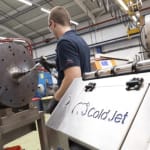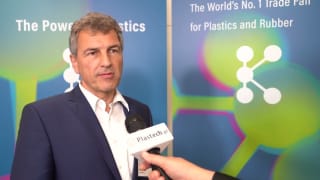
Jokey is one of the largest packaging manufacturers of rigid plastic with worldwide influence. The company fabricates plastic buckets, boxes and trays according to a process of plastic injection molding. For 50 years, Jokey’s name has been recognized as the guarantor of an outstanding expertise in injection molding and customer-focused service. With 2,000 employees, they manufacture their products in 15 factories in 12 countries and serve customers in approximately 80 countries.
Cleaning the tools is a crucial step in their production process, especially when it comes to meeting the strict standards of quality and hygiene required by the food industry.
“Cleaning is very important for our finished product because it has a direct impact on our product quality. In addition, some of our products are intended for the food market so cleanliness is essential,” said Mr. Fontaine, Mold Workshop Manager.
Jokey’s team cleans the molds at the end of each production cycle and each time the tools have to be modified or require maintenance. The company has also set up a preventive maintenance schedule in which cleaning is one of the critical phases.
All Jokey plants comply with a strict quality and hygiene management system, audited and evaluated by independent auditors in accordance with the international BRC/IoP standards for packaging and packaging materials, as well as DIN EN ISO 9001:2015 and DIN EN ISO 14.001:2015.
The problem
Because of the very high hygiene quality requirements, the Jokey plant needs a full-time operator (sometimes even more depending on the production series) to clean their injection molds. Before using the Cold Jet dry ice blasting system, the cleaning was done by hand on press or the mold was removed from the machine and then cleaned with cloths and cleaning products such as aerosolized food solvents or in a degreasing fountain.
“Sometimes it was necessary to dismantle and move equipment for cleaning,” said Mr. Fontaine. “This had us concerned because there was undoubtedly a loss of production during the shutdown. During these stops, the mold could not be used from 30 minutes to 2 hours and could monopolize a mold maker for cleaning. In extreme cases, a disassembly of the mold could be necessary, which resulted in a loss of up to 3 additional hours of production. These production stops could last between 1 and 5 hours and therefore generate significant production losses. When starting up production, we could also lose between 50 and 200 parts for the removal of food solvent traces on the finished product.”
“The previous cleaning solution could have an impact on product quality. For example, we sometimes had to stop a press after a cleaning so that we could intervene on traces of persistent dirt in hard-to-reach areas. The finished product that did not meet the quality criteria had to be destroyed,” says Mr. Fontaine. “For a few cases, we had to redo some of the orders because they did not meet our quality criteria.”
“Another concern was the safety of our operators, because the previous cleaning process could pose problems, in terms of health, caused by solvents in aerosols or the degreasing fountain. These products required medical validation and had to have food certificates.The manual cleaning on press was really not effective. Depending on the mold, it took between 45 minutes and 2 hours. We faced many challenges using the old system, like the quality in terms of cleanliness. It was difficult to access and clean some places. It took us a long time and the use of rags and solvent cleaning products was excessive.”
The solution
Before choosing dry ice cleaning as a method, the company tried ultrasonic cleaning as well as soda blasting, but without any success. The company must comply with ISO 14001 and uses optimized production systems such as 5S and internal production tracking systems.
“Dry ice cleaning supports our programs because it saves us time and therefore optimizes production time,” said Mr. Fontaine. “The quality of the cleaning is also better.”
“The Cold Jet cleaning system is compact, easily movable and very efficient while remaining easy to use. The cleaning time is reduced by about 50% and sometimes even more. The time saved will be more significant on a 4-cavity mold because there is much more cleaning to be done than on a smaller mold (1 cavity). It can also depend on the number of parts that make up the mold because the more parts there are to dismantle, and therefore to clean, the more time saved will be significant. Dry ice blasting has freed up time for our mold makers to perform more complex maintenance or machining operations requiring a high level of expertise.”
The results
Cold Jet dry ice blasting has been beneficial for:
- Reduction of cleaning times
- More accurate and efficient cleaning
- The elimination (or very significant decrease) in the use of chemicals
- Lower costs through the elimination of soiled cloths
- The decrease in start-up waste
- More environmentally friendly
“The initial investment remains significant, but the return on investment is relatively rapid,” said Fontaine. “Cold Jet’s return on investment was calculated before the machine was purchased for use in our mold shop only. This compares our old cleaning solution with the Cold Jet cleaning solution. The times could be measured thanks to the loan of the machine for one week under real operating conditions. At that time, we noted that profitability was achieved in less than 2 years (excluding the cost of stopping production and recycling of soiled cloths and aerosols).”
“With the Cold Jet cleaning system, staff use fewer chemicals and cleaning time is reduced. In addition, the system is more rewarding and efficient. The results obtained are much better and the operators don’t have to do double the work. For the moment, we are waiting to make the Microclean machine profitable and to see all the potential uses in all the plant’s departments.”




